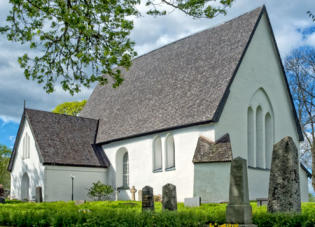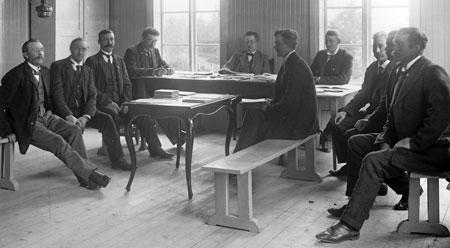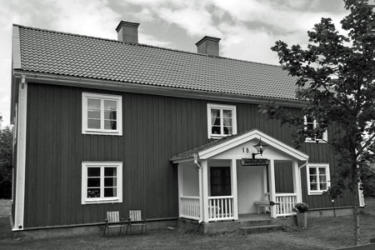

Copyright © Hans Högman 2021-09-22


The Concept of Socken and
Sockenstämma in Sweden
Introduction
“Socken” is usually translated into “parish” in English
and “sockenstämman” into “parish council”. However,
it is more complicated than this since the “socken”
had dual purposes;
•
Rural church parish
•
Rural civil local government.
The local parliament in a “socken” (parish) was called
“sockenstämma” (parish council) and
“sockenstämmomöte” then parish council meeting.
“Sockenman” is an older term for a person who has
the right to vote at the “sockenstämma”. The
“sockenstuga” (parish hall) was the building where
the parish council held its meetings, or for other
types of meetings.
The sockenstämma (parish council) was the highest
decision-making body in each socken (parish) until
the 1862 municipal ordinances when the socken
was divided into an ecclesiastical (Församling) and a
civil municipality (Kommun).
The Establishment and Development of the
Socken (Parish)
The ecclesiastical leadership in Sweden became
more and more active at the end of the 11th century
and during the 12th century, which resulted in the
introduction of dioceses. In 1164, Sweden became
its own church province with an archbishop in
Uppsala, and only then did a real parish formation
(socken) take place, largely linked to the building of
parish churches with cemeteries common to
several villages, and to the introduction of the tithe
institution, which by the end of the 13th century
was fully regulated in Sweden.
The formation of parishes took place in different
ways in different provinces. In Sweden, the parish
(socken) and its inhabitants were given a kind of
autonomy that was unknown in canon law. In the
ecclesiastical codes of the provinces, the priest and
the parishioners are two parties with reciprocal
rights and obligations.
In the Middle Ages, the Church Code was the text of
the law that contained the law of the church, i.e. the
public law regulation of the relationship between
the state, provinces, parishes, and individuals on the
one hand and the church on the other. The Swedish
provincial laws began with a church charter that
regulated the parishes' obligation to build and
maintain churches, their right to appoint priests, and
parish clerks and their obligation to maintain them
and pay for their services, which they were obliged
to perform. In time, the Uppland province Law's
church charter became the most widely used. Some
common rules were introduced in the 1571 Church
Ordinance, but otherwise, the Uppland Law Church
Code applied until the 1686 Church Act.
Already in the Middle Ages, the parish (socken) had
functions that were not directly related to the
church, with the parishioners themselves judging
certain cases. This resulted in the development of
formal parish assemblies (sockenstämma). The
church parish is thus the origin of civil local
government in Sweden, which is now exercised
within the framework of the municipalities
(kommun).
Since 1682, all Swedish parishes have in turn been
administratively divided into “rotar” (districts). The
peasants in a rote were jointly responsible for
various tasks, such as military rote (soldatrote,
båtsmansrote, or ryttarrote), care of the poor
(fattigrote), annual household examinations
(husförsrote), and so on.
During the 17th century, there was a tendency for
the parishioners, indirectly through church councils
or directly through parish assemblies, to participate
more and more in the governance of the churches.
During the 17th, 18th, and 19th centuries the parish
assemblies (sockenstämma) developed into
important local administrative bodies. They decided
above all on the church's finances and buildings and
the order of the church.
Through the exercise of parish authority and
discipline and decisions on poor relief and health
care, the parish council took on a more
comprehensive responsibility for the organization of
local society. The parish council consisted of the
parish minister and his congregation, with the
wealthy peasants as the leading members. This
parish council autonomy then formed the basis for
the rural municipalities (landskommun) that were
established in 1862.
The Socknen
The parish thus had two functions integrated into
a single body, as a church parish (rural parish) and
as a civil parish (parish municipality), which was the
local government.
The parish (socken) was an administrative area
consisting of several adjacent villages and towns.
The “socken” had a parish church, was governed by
the parish council, and was a precursor to today's
municipalities.
The term “socken” has also been used as a unit for
land registration (jordeboksocken, later
jordregistersocken).
The image
shows the
parish church
in Härkeberga,
Enköping
pastorat,
Uppsala
diocese.
Wikipedia.
PDM.
The church is a medieval parish church built in grey
stone and brick. The nave, chancel, and sacristy
were built between 1280 and 1310, while the nave
was added in 1475-1480. The organ loft was built in
1773 and the organ itself was added in 1811. The
bell tower dates from the second half of the 17th
century.
In southern and central Sweden, the parish division
was introduced early and has not undergone any
fundamental changes since the Reformation. In the
forest regions, chapels were established in various
places, which could eventually be separated into
their own parishes and regarded as socken. This
happened to a particularly large extent in Norrland,
the northern half of Sweden. At most, there have
been more than 3.000 parishes in Sweden.
From 1682, the parishes (socken) were
administratively divided into “rotar” (districts).
The parishes were governed by the parish council
(sockenstämman), as an administrative unit.
Sockenstämman (Parish Council)
The parish council (sockenstämman) was the highest
decision-making body in each parish until the 1862
municipal ordinances when the socken was
divided into an ecclesiastical and a civil
municipality.
A separate church council was already established
in 1817, and the municipal reform of 1862 meant in
practice only that the parish council (sockenstämma)
changed its name to kommunalstämma (municipal
assembly).
The image shows a municipal meeting
(kommunalstämma) in Bodum parish, Ångermanland
between 1900 and 1910. Nordic Museum. Wikipedia.
PDM.
The parish council (sockenstämman) as an
institution probably emerged at the same time as
the first parishes. The early parish councils took
decisions on the maintenance of the church and the
management of its assets. As far as is known, the
parish council was not involved in the administration
of justice during Catholic times or in the decades
following the Reformation.
At the Uppsala meeting in 1593, demands were
made for tighter religious control and moral
renewal. This was the starting point for parish law,
which was then developed during the 17th century,
including the introduction of “sexmän” (sexmen).
A parliamentary decree established that the
population should be involved in judging sinners.
However, the legal basis for the parish councils'
activities remained vague for a long time. The 1650
priestly privileges stated that the clergy should
bring to justice those who had broken God's
commandments in various ways.
However, the relationship with the secular justice
system was not mentioned. The local police chief
(Länsman) and his deputy (Fjärdingsman) became
responsible for carrying out the punishments.
King Karl XI transferred much of the parish
jurisdiction to secular courts. Following a resolution
in 1684, cases of guardianship, wills, disputes over
pews and burial places, noise, controversies, and
fights in the church, and oaths and Sabbath-
breaking were placed entirely under secular
jurisdiction. The Church Act of 1686 further limited
the jurisdiction of the Church.
The 1723 priestly privileges stated that a parish
meeting (sockenstämma) should be held twice a
year, at the call of the parish minister, who also
acted as chairman and took the minutes. Two
meetings a year was a minimum requirement, more
meetings could be held as needed. According to the
same privileges, all "parishioners" (sockenmän) had
to participate.
Sockenman (Sockenmän in plural) - parishioner - is
an older term for a person who has the right to
vote at the parish meeting. In the old days, it was
the wealthy peasants who had the right to vote at
the parish meeting, i.e. those who paid the annual
tax on their yields. In the 19th century, the rules
were changed and the tax paid became the basis
for determining who was a full “sockenman”. The
concept disappeared with the introduction of the
1862 municipal ordinances.
Before 1817, there was no law regulating the
activities of the parish council. Earlier constitutional
regulation of the work of the parish council was
section 23 of the 1723 priestly privileges (1723 års
prästprivilegier). It states that the priest shall hold
two annual parish meetings and that "all
parishioners" are obliged to attend. Nothing more
than the fact that the meeting consisted of the
chairman (the parish minister) and the parishioners
were stipulated, but there were no directions on
how the decisions were to be made, enforced, or
appealed. Nor does the 1734 law give any indication
of this.
The 1817 decree regulated this field. This decree
concerning parish meetings and church councils in
practice only confirmed older practice and did not
really change anything. However, one innovation
was that a church council was to be elected in each
parish; the parish minister and churchwardens were
self-appointed to the church council, and in addition,
four to eight members were also to be elected.
Parish jurisdiction was transferred entirely to the
church council.
The 1843 ordinances on parish meetings
(sockenstämma) and parish committees
(sockennämnd), on the other hand, represented a
major change. Although there was nothing new
about the form of the parish council, a parish
committee was introduced, to be elected by the
parish council. It was to consist of an elected
chairman (not necessarily the parish minister) and a
'suitable' number of members elected for two years.
The parish committee was not given many directly
defined responsibilities; it was to deal with health
care and order and morality, but otherwise to deal
with matters transferred to it by the parish council
(sockenstämma).
This meant that the executive organization of the
parish council may now be considered divided; the
parish committee for the civil matters and the church
council for the ecclesiastical ones.
What kind of matters were dealt with at the
Parish Council Meetings?
What issues would be the responsibility of the local
self-government and how would these issues be
dealt with?
The 1723 Priestly Privileges set out the
responsibilities of the parish council in a very
general way as "the affairs of the church" and matters
concerning the "requirements and orders of the
parish". However, it is specifically mentioned that the
council is to examine the church's accounts.
In the 1817 Ordinance, paragraph 6 states in
general terms that the council shall deal with 'the
care of the church and the financial and general affairs
of the parish, followed by examples of various
matters concerning the church and its personnel,
such as the election of trustees and representatives,
'educational institutions', parish finances, care of the
poor, parish craftsmen, fire protection, wild game
bounties, parish storehouse matters, health care
and general supervision of order and morality.
The affairs of the church have been at the center
of the parish council since the priestly privileges of
1723, especially the management of the church
building itself and its furnishings, the parsonage and
other parish buildings, as well as the funds and
property belonging to the church as a legal entity.
The election of the parish minister was carried
out at the parish meeting, as was the election of
other officials such as the parish clerk and organist
(Klockare).
The care of the poor has been of great importance
to the parish and, from 1842, the school as well.
The 1842 Act (Folkskolestadgan) made an
elementary school compulsory in every parish and
introduced a new body, the school council. The
parish minister was the obvious chairman of the
school council too.
About a third of the meetings of the parish council
dealt with questions of repairs or rebuilding of the
church and parsonage. Other matters included the
election of parish scribes, sexmen, churchwardens,
vergers, parish clerks (klockare), organists, and
parish tailors. Questions concerning the parish
administration were also common.
Other issues dealt with were matters concerning the
parish's finances and questions concerning the
poor, the parish storehouse, education, and the like.
The parish council as an institution changed during
the 18th century and matters concerning the parish
storehouse, fire protection and the poor became
more common, while the parish administration of
justice decreased in importance. This development
continued in the 19th century when the care of the
poor and other social issues became an increasingly
important part of the parish council's activities. As
mentioned above, public education became a parish
matter in 1842.
The parish council thus often had to deal with
matters involving the election of persons to
various positions of trust in the parish, such as
sexmen, committee members, possible monitors,
and the like.
Becoming a sexman was not always popular with its
duties such as collecting parish funds, supervising
the poor, reporting morality issues, etc. There are
many examples of the election of trustees where
people did not want to take them on and wanted to
get rid of them as quickly as possible.
There were also elections that the parish council was
required by law to conduct. These included the
election of lay assessors (nämndemän) to the district
court (Häradsrätten), members of the property court
(ägodelningsrätten), etc. From 1830, the meeting
also had to appoint a parish deputy police
constable (fjärdingsman), who was not really a
trustee but an official at the parish level.
Road maintenance within the hundred (härad -
county district), bridge maintenance, and stage
service were other typical issues. These matters
also required negotiations between the Crown Bailiff
and parish representatives from a larger area.
The meeting also appointed the officers in charge of
the parish fire pump, known as "Officianterne vid
Socknens Brandredskap".
Fire protection was becoming increasingly important
for the parish. The meeting dealt with issues of fire
protection in the parish, such as the acquisition of
fire pumps and other equipment, both for the
church and for common use, and appointed fire
brigade chief (brandrotemästare). The meeting also
elected members of local and regional fire brigade
societies.
Sockenstugan - The Parish Hall
The parish hall (sockenstugan) was the building
where the parish council held its meetings, or for
other types of meetings, such as the church council.
Parish halls were built in Sweden from the 17th
century onwards, but even at the end of the 19th
century, many parishes lacked their own parish hall.
The residents of the parish, except for the clergy,
had an obligation to contribute to the costs of
maintaining the parish hall. The parish hall was
usually located next to the church.
The image shows the parish hall in Ulrika parish,
Linköping municipality, Östergötland. Wikipedia.
PDM.
Voting at the Parish Meetings
Usually, the parish council took decisions by
consensus and any votes were taken by the set
mantal (taxation unit of land). A farm unit of a
greater mantal produced a greater yield than a farm
with a smaller mantal.
In the "parish meeting ideology", the ideal was that
the wise and impartial administrators of the parish,
i.e. pastor, churchwardens, parish council, etc., put
forward proposals, which were then discussed to
arrive at the "right" final solution. Everyone then
unanimously agreed to the solution discussed. The
strong consensus ideal meant that disagreements
were usually resolved by compromise, but if the
unanimity was broken by some parishioner
maintaining a dissenting opinion, things became
more difficult.
In such cases, the 1817 ordinance provided for
voting by mantal with majority decision as a way
out of the disagreement.
Majority voting had also been used earlier for the
election of elected officials and trustees. But then
there was no problem of a financial burden being
placed on the dissenters against their will. The
financial burden of maintaining the parish clerk
(klockaren), for example, was already there, it was
only the incumbent who had to be appointed.
In other matters too, binding majority decisions
became increasingly common during the 19th
century; at different rates in different parishes.
How often were Parish Meetings Held?
The two parish meetings per year prescribed in the
1723 priestly privileges were almost always too few
(as were the three statutory municipal meetings
after 1862). There were many other statutory
reasons for calling a meeting. The number of
meetings per year increased during the first decades
of the 19th century when the existing legislation
placed more and more tasks on the parish council.
The number of issues per meeting was usually
quite small according to the minutes. Matters were
dealt with at the pace required rather than piling up
in anticipation of a larger meeting. Two compulsory
parish meetings per year, in fall and spring, were
provided for in the 1723 priestly privileges and
legislated in 1817 and 1843. After 1862, three
meetings were compulsory.
The parish minister had to call a meeting 8 - 14 days
in advance from the church pulpit. If necessary, the
meeting could be held more often than the two
obligatory ones and it could also be held at the
request of the congregation. The parish minister
kept the minutes of the meeting, but they had to be
corrected and read out in the church.



The Concept of Socknen,
Sweden
Who had the right to attend and vote at the
meeting?
The members of the parish council were the parish
minister and the parishioners (sockenmän), and the
minister was the obvious chairman of the parish
council. In the 1723 priestly privileges, it is stated
that "all parishioners" must participate in the
meeting. However, it is not clear from this ordinance
whether "parishioners" means all male persons in
the parish or all homestead owners/farmers. This is
only specified in the 1817 ordinance as owners of
properties set in mantal, i.e. homestead owners
(hemmansägare).
Attendance at the meeting was rarely recorded in the
minutes, and the minutes only exceptionally record
who participated in the discussions. When
attendance was recorded, it was usually overall. Only
those who were considered "important" in the parish
were recorded as present. In the minutes of a parish
meeting held in Turinge parish in May 1816,
attendance was recorded as being attended by
Messrs Elgenstierna, Iggberg, and Besk and "a large
group of the parish's peasants". The speeches of the
members of rank have been referred to in detail,
sometimes with the requirement that their speeches
be included verbatim in the minutes.
Those who normally attended the parish meetings
were usually representatives of the parish landed
estates (the owners or their trustees), the "better
farmers" of the parish, often with titles such as
churchwarden, lay assessor or circuit judge, and a
group of other farmers, mainly freehold farmers.
Crofters (a type of tenant farmer) could be required
to contribute to various works and expenses without
having any influence on the decisions.
Participation in the meeting by non-landowning
groups such as crofters, farmhands, and laborers
was limited; even if they were able to attend the
assembly, they had no means of taking action.
In 1815, the law did not yet regulate who could
participate in the meeting, how the meeting should
make decisions, or to what extent these decisions
were binding. However, various provisions required
that a majority decision could be taken.
The decree of 1817 formalized the previously
scattered rules on voting rights at the parish
meeting. According to the decree, persons in the
parish who were owners of properties in set
mantal, i.e. homestead owners, had the right to vote
at the meeting.
However, rural residents (tenant farmers) could
vote if the landowner had given them the right to do
so in writing. It was also stipulated that it was
forbidden for others to "intrude" on the meeting, i.e.
the meetings had to be closed. It is now clearly
stated that decisions that are taken at the meeting
also apply to those not present. From now, there
were clear rules on this.
Already in 1824, an important change came. In
matters that did not concern dues to the parish, but
"what for order and morality ... should be observed",
the right to vote was also extended to persons who
cultivated other people's land, without the need for a
special power of attorney. In other words, it was now
possible to vote according to principles other than
the mantal in matters that did not concern municipal
levies. The participants in the parish council were no
longer such a clearly defined group.
According to the 1817 decree, the meeting could
make binding decisions even for those who were not
present. The Ordinance contains a paragraph stating
that "the absence of a member shall not hinder the
progress of the meeting".
A weakness of the 1817 Ordinance was that it did
not contain a limit on the number of participants
with voting rights required for decisions to be
taken. To make matters worse, a single person
entitled to vote could control and vote at the meeting
if no other person entitled to vote was present.
There was also no provision for this in the 1843 and
1862 legislation. Therefore, one sometimes finds
meetings where the meeting postponed decisions
due to poor attendance.
The 1843 decree introduced new regulations
concerning the right to vote and the counting of
votes. As before, the right to vote extended to
landowners or tenants who had received the owner's
power of attorney.
Those who did not own land but paid a certain
minimum amount of state tax on their income and
wealth were now also entitled to vote. Voting rights
were calculated in such a way that 2 riksdaler 24
skilling in appropriation was equal to the possession
of 1/16 mantal. As before, it was stipulated that the
chairman of the meeting could expel non-voting
members from the meeting if they behaved
'improperly'. In other words, non-landowners were
given greater influence from 1843.
The 1862 municipal ordinances introduced the so-
called quadrangle. Still, ownership of land set in
mantal was compared to an appropriation for
income or wealth. What was new, however, was the
introduction of a new counting unit for votes, the
"fyrk". Furthermore, cultivating other people's land
was now equated with landowners.
However, the land as a basis for voting was abolished
in 1863 when the counting of the mantal was
abolished and only the appropriation was used;
however, the appropriation for agricultural
properties was to be counted twice, so the old
proportion was retained.
As regards participation in the meeting, the 19th
century saw a change that broadened participation.
From exclusive landowners in 1817 to also other
taxpayers in 1843 and from 1862 also the rural
inhabitants, who at that time were now called tenant
farmers (arrendatorer).
The parish council was thus the meeting place of the
homestead owners and the landed gentry, not of the
crofters, the farmhands, or the workers.
Where was the Power in the Parish Council?
With the parish ordinance of 1817, the power to vote
was formally given to the owners of land in mantal.
The grading of the parishioners' votes was in
proportion to the mantal of the respective
parishioner's homestead (based on the yield - larger
yield, larger mantal).
In May 1819, the parish of Spånga dealt with a
matter concerning whether to rebuild the church
tower or to build a separate bell tower. At the
meeting, the mantal of the six homestead owners
present was counted and it was decided that the
church tower should be repaired.
Five freeholders have voted with fractions of a
mantal, but the sixth participant, a master gardener
Lagerbom with power of attorney from Count Trolle
Bonde at Hässelby Manor, decided the question with
his 15 ½ mantal. The total mantal of the smaller
farms was far away from Count Trolle's 15 ½ mantal.
Large landowners thus had many votes, while small
farms did not even get a full vote.
Generally speaking, the landed gentry had a stronger
position at the meeting than the freehold farmers,
and the freehold farmers in turn had a stronger
position than the tenant farmers, while the crofters
had little to say about.
The 1817 decree on voting by mantal should not be
seen as a new invention. The 1817 regulation simply
set down the previous practice.
Sockenman
Sockenman was the name of a person who had the
right to vote at the parish meeting. In earlier
times, it was not clearly expressed in law who was
meant by sockenman, but of course, there was a
practice even if it was not written down in law. It is
likely that even before 1817, it was wealthy
homesteaders - i.e. those who paid the annual tax-
who had the right to vote at the parish council.
In 1817, the regulations were changed and the
mantal tax paid became the basis for determining
who was a full sockenman (parishioner).
The concept of sockenman disappeared with the
introduction of the 1862 municipal ordinances.
Control of Migration to the Parish
The parish would also control migration to the
parish. In order to protect the parish from having to
provide for poor non-parishioners, it was decided in
1788 that no old or less able-bodied servants could
be admitted to the parish without the approval of the
parishioners at a parish meeting. The control of the
population register was of great interest to the
parishioners. This right to inspect and reject
potential entrants ended with the 1847 Poor-Law
Relief.
The 1842 Elementary School
Charter (1842-års folkskolestadga)
According to the 1842 Elementary Schools Charter
(Folkskolestadgan), there should be at least one
school in each parish and town. This school was to
be permanent and have a qualified teacher. The
requirements were thus one school per parish and
one teacher per school. There was no class division,
but all age groups had to attend the same class. The
school was to be run locally, i.e. by the parish. So in
1842, the education of the children became a parish
matter. Until then, the parish council had made the
care of the poor its most important task.
The elementary school was received with moderate
interest. The peasantry, for whom the school was
primarily intended, was not convinced that it was
needed. In wealthy homes and homesteads,
homeschooling continued as before. When the
public elementary school was established in 1842,
there was no compulsory schooling for the
children, but the elementary school merely imposed
a duty on the parish to establish a school.
Compulsory schooling for children was first
introduced with the 1882 Folk School Act.
When the socken was split into a civil municipality
and a church parish in 1862, the school went with
the church.
Municipal Reform of 1862
(Kommunreformen)
The structure of the parish council, laid down in the
1817 and 1843 ordinances, was largely retained
during the Great Municipal Reform of 1862
(Kommunreformen): the parish council and the parish
committee were renamed the municipal council
(kommunalstämma ) and the municipal committe
(kommunalnämnd).
The number of elected trustees increases: both the
council and the committee would now have elected
chairmen and vice-chairmen. The committee became
a more purely executive body; it would execute
everything decided by the municipality (Kommun) as
well as supervise the execution handled by others.
The committee was given more tasks concerning the
municipality's finances.
The parish minister was no longer the mandatory
chairman of the council. However, he was given his
own municipal responsibility, the purely
ecclesiastical parish (church parish -
“kyrkoförsamling”). In other words, all ecclesiastical
affairs were now separated from the civil municipality.
In the ecclesiastical parish there would be a church
council and a church committee with tasks similar to
those of the civil municipal bodies. The municipal
reform (kommunreformen) stated that the municipal
executive board (kommunstyrelsen) would deal with
"common order and economy affairs". The 1862
municipal reform came into force on 1 January 1863.
Both the church parish and the civil parish - The
Socken - were thus abolished as administrative
units in the municipal reform of 1862, but the land
register parish continued to be used.
After the abolishment of the old double purposed
socken in 1862, the church socken is now called
“Församling” in Swedish and the civil socken
“Kommun”.
In other words, the socken were replaced in 1862 by
two newly created administrative bodies for the
same geographical unit: the civic rural municipality
(Landskommun) and the ecclesiastical parish
(församling).
Their highest decision-making body was still the
council, i.e. the municipal council (kommunalstämman)
and the church council (kyrkostämman) respectively.
However, since these municipalities usually covered
the same territorial area as the old socken, the identity
of the territories continued to exist.
Thus, there were now three types of civil
municipalities: cities, boroughs (Köpingar) and rural
municipalities (Landskommuner), as well as an
ecclesiastical one: the parishes (Församlingar).
Furthermore, in 1862 a new form of regional
municipality was created, the Landsting (The County
Council).
When the socken was split into a civil municipality and
a church parish in 1862, the school went with the
church. For a long time to come, the municipality
(kommun) had no involvement in school matters.
Subsequently, the division of municipalities has
changed through extensive mergers in 1952 and
1971.
In 1952, large municipalities (Storkommuner) were
created by merging rural municipalities, and in
many cases the link between the old socken and civil
municipality (Kommun) was broken. At that time, the
2281 mainly socken-based rural municipalities
disappeared as municipal units and were replaced by
816 "large municipalities" (storkommuner).
On 1 January 1971, a uniform type of municipality
was introduced, when all former rural municipalities
(Landskommuner), towns/cities and boroughs were
transformed into municipalities only (Kommuner).
Since most municipalities included both rural and
urban areas and all had the same legal status, there
was no need to retain different names, they were all
called “Kommun”.
Comparison to the USA
The municipalities in Sweden cover the entire
territory of the nation. Unlike the USA or Canada,
there are no unincorporated areas.
In 1971 the formal differences between city and rural
areas were removed and all municipalities are from
then a uniform type with no local statutes or
privileges of any kind.
The U.S. term consolidated city-county probably
best describes the Swedish Kommun as of 1971.
In United States local government, a consolidated
city-county is a city and county that have been
merged into one unified jurisdiction. As such it is
simultaneously a city, which is a municipal
corporation, and a county, which is an administrative
division of a state. It has the powers and
responsibilities of both types of entities.
However, the consolidated city-county doesn’t exist in
all of the US states.

Related Links
•
Socken - Terminology
•
Poor Relief in the past
•
History of the Swedish School System
•
Apprentices, Journeymen, Master Craftsmen -
Swedish Craft Guilds
•
History of the Swedish Police
•
The History and Organization of Church of
Sweden
•
Landownership - Farmers & Crofters
•
The Old Agricultural Society and its People
•
The subdivisions of Sweden into Lands,
Provinces and Counties
•
The History of the Swedish Riksdag
•
Swedish Land Reforms
Source References
•
Sockenstugans politiska kultur. Lokal
självstyrelse på 1800-talets landsbygd. Harald
Gustafsson, Stadshistoriska Institutet, Studier i
stads- och kommunalhistoria 6, 1989
•
Herraväldet i helgedomen: Uppsala domkyrkas
förvaltning cirka 1530–1860, Upplandsmuseets
skriftserie Nr 5, Örjan
Simonson/Upplandsmuseet, 2008
•
Kommunernas historia (sockenstämman)
Nordisk familjebok / 1800-talsutgåvan. 8. Kaffrer
- Kristdala / 1115-1118
•
Kommunernas historia (sid 672-676) i Nordisk
familjebok (andra upplagan, 1911)
•
Sockenkyrkorna - Kulturarv och
bebyggelsehistoria, Markus Dahlberg & Kristina
Franzén, Riksantikvarieämbetet 2008
•
Sockenbildningen i Sverige, doktorsavhandling,
Stefan Brink 1990
•
Wikipedia
Top of Page





































































































































































































































































































































































































